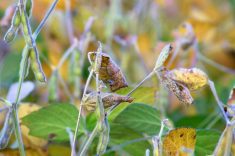Soybean cyst nematode (SCN) is a serious soybean pest throughout the American Midwest and, as of 2021, it’s been confirmed in five Manitoba municipalities.
There are two ways a farmer can deal with soybean cyst nematode, according to Iowa State University plant pathologist Greg Tylka.
“The first thing is don’t grow soybeans — but my soybean association asked me to rephrase it as growing non-host crops,” he said, speaking to the Manitoba Agronomists’ Conference earlier this winter.
Read Also

Still hard to predict precise fertilizer payback
Despite decades of advances, international research finds no clear answer for where and when adding nutrient will fail to boost growth.
“The main management strategy is cyst-resistant soybeans. By switching the seed that you plant you can go from stunted yellow beans that yield poorly to very vigorous tall green soybeans.”
Manitoba farmers can rotate to a number of non-host crops such as barley, oats and corn as well as the stalwarts, wheat and canola. Potatoes are also on the non-host list and, like the nematodes themselves, they favour the sandier soils. The nematode likes edible beans though, so if you have a problem with SCN, you might not want to put these crops in the rotation.
“In fact some edible beans are better hosts for soybean cyst nematode than soybeans and there’s research that shows, not surprisingly, SCN would decrease the yields of those edible beans,” Tylka said. “And then with the green peas, it’s a really weird plant, some varieties are good hosts and others are not, so you’d have to be careful with peas.”

The deep, dark problem is that the eggs — and SCN females lay a lot of them — don’t all hatch the next year. Many of the eggs will wait a year or two before they release a juvenile worm so there is a gradual decrease but it’s deceptive. Tylka explained why by looking at a rotation away from soybean to a repeated corn on corn on corn.
“Forty to 50 per cent of the eggs are dormant and they’re not going to hatch out that first year or even a second year,” he said. “It’s the non-dormant eggs hatching out in first-year corn, in second-year corn and by the time you get to third-year corn there’s hardly anything left in the soil except for dormant eggs. Those are going to slowly hatch out over a period of many years.”
Those dormant eggs will lie in the soil for years waiting for the next soybean crop. The best management strategy for dealing with SCN is genetic resistance, the ability of the plant to keep the pest from feeding on it. The nematode lives in the soil and feeds on the root and this hurts the plant and hampers its production so a plant that prevents this kind of damage is a more productive plant.
“The definition of a resistant soybean is a variety that allows less than 10 per cent reproduction compared to a susceptible variety,” Tylka said. “In a greenhouse study, if a susceptible plant supported 200 females per root a resistant plant would support 20 females or less.”
So if the females can’t feed, they can’t reproduce and resistance causes a drastic reduction in SCN reproduction. The trick is to find soybean strains that are resistant to invasion from the nematodes and there are quite a number of them, most of them from Asia. Tylka says that there are seven main sources of resistant genetics but the two principle strains are Peking and the numerical PI 88788.
“Make no mistake though, even though these are soybeans, they are horrific when it comes to agronomics,” he said. “No one in their right mind would grow pure Peking or pure 88788, but soybean breeders take these and cross them with good agronomic varieties and then select for offspring that maintain those good agronomics and have these SCN-resistance genes.”
So this is good news and Tylka talks about the number of resistant strains of soybean he’s seen produced over the years. In 1991 he made a list of resistant varieties that filled about one sheet of paper. Now that list fills a booklet 24 pages long.
Unfortunately, most of the genetics come from those two early sources, Peking and PI 88788 — and it’s starting to break down.
“Unfortunately, for my state, and for much of the upper United States, the varieties that are available only have resistance from these two sources. Ninety-five per cent of our varieties have 88788 resistance and about five per cent have Peking resistance,” he said. “The rhetorical question would be: Is there any reason this won’t happen in Canada eventually? Albert Tenuta and I think Tom Welacky in Ontario have data to show that nematodes in Ontario are building up the ability to reproduce on 88788.”
While the Peking genetics still provide high resistance, Tylka has watched PI 88788 strain resistance drop significantly since the 1990s. He’s conducted field studies over several seasons and found increasing levels of SCN reproduction in fields of 88788 soybeans. One trial in 2001 showed that 28 per cent of the nematode females were able to reproduce, a significant increase from the acceptable 10 per cent and this is causing yield losses in a vital Midwestern crop. Would it be a good idea to move toward Peking resistance?
“We would never want farmers to switch completely to Peking,” Tylka explains. “Peking is working better because we’ve exhausted the effectiveness of 88788. Mother Nature finds a way to overcome that so we’ll eventually lose the effectiveness of Peking. We want to mix 88788 and Peking resistance moving forward.”















